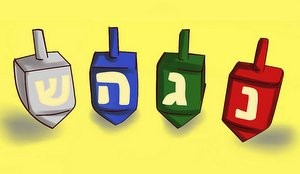What is Hanukkah?
Hanukkah (which in Hebrew means ‘to dedicate’) is also referred to as the Festival of Lights or the Feast of Dedication. It is a holiday, lasting eight days, that celebrates the re-dedication of Jerusalem’s temple in 164 B.C.
Here is a brief history of Hanukkah. In 175 B.C., Antiochus Epiphanes became ruler of the Seleucid Empire. His goal was to unite the Greek-related elements of his empire and to force, if necessary, those who did not live based on the Greek culture (e.g. those in Judea) to do so.
In 167 B.C. he ordered that a pagan altar dedicated to the false god Zeus be placed inside the temple in Jerusalem. Unclean animals like pigs were ordered to be brought to the new altar and sacrificed. Right after this occurred a man named Mattathias, a priest who served in the temple, began a revolt against the Seleucids by refusing to worship the Greek gods forced on Judea by Antiochus.
Although Mattathias soon died after the revolt started, his son Judas assumed his dad’s leadership role and continued the rebellion as its military commander. He was so zealous and ferocious in battle that he earned the name Judas Maccabaeus (or Judah the Maccabee), which translated as “Judah the Hammer.”
Judas eventually lead the people to a stunning victory over the Seleucids. He entered Jerusalem after Judea won back its independence. He had the pagan altar erected by the Seleucids removed from the temple, had the temple itself religiously purified, and restored the worship of the true God. The re-dedication of Jerusalem’s temple happened on the twenty-fifth day Kislev, which is roughly our month of December. Tradition states that although only one day’s worth of oil could be found for the Temple’s menorah, which burned all through the night, it somehow burned for a total of 8 days. This period was the same as the time it took to prepare and dedicate new oil for the Temple.
When the royal Hasmonean family overpowered and was victorious over the Greeks, they searched and found only a single cruse of pure oil… enough to light the menorah for a single day. A miracle occurred, and they lit the menorah with this oil for eight days. On the following year, they established these eight days as days of festivity and praise and thanksgiving to God. (Talmud, Shabbat 21b)
Traditions
Hanukkah has never been considered a very important religious holiday even though it is often celebrated in our modern world due to its proximity to Christmas. The holiday’s religious significance is far less than that of Rosh Hashanah, Yom Kippur, Sukkot, Passover, and Shavu’ot. It is roughly equivalent to Purim in significance, and you won’t find many non-Jews who have even heard of Purim! Hanukkah is not mentioned in the Old Testament; the story is related in the apocryphal book of Maccabees, which is not accepted as scripture by either the Jewish or much of the Christian community.
Religious
The only religious observance related to the holiday is the 8-day ceremony of lighting of candles in commemoration of the miracle of the multiplying of the oil. The candles are arranged in a candelabrum called a menorah that holds nine candles: one for each night, plus a shammus (servant) at a different height.
Food and Gifts
It is traditional to eat fried foods on Hanukkah because of the significance of oil to the holiday. Among Ashkenazic Jews, this usually includes latkes (pronounced “lot-kuhs” or “lot-keys” depending on where your grandmother comes from. Pronounced “potato pancakes” if you are a goy.)
Gift-giving is not a traditional part of the holiday, but has been added in places where Jews have a lot of contact with Christians as a way of dealing with children’s jealousy of their Christian friends. It is extremely unusual for Jews to give Hanukkah gifts to anyone other than their own young children. The only traditional gift of the holiday is “gelt,” small amounts of money.
Playing Dreidel
Another tradition of the holiday is playing dreidel, a gambling game played with a square top. Most people play for matchsticks, pennies, M&Ms, nuts, or chocolate coins. The traditional explanation of this game is that during the time of Antiochus’ oppression, those who wanted to study Torah, which was an illegal activity, would conceal their activity by playing common and legal gambling games with a top whenever an official or inspector was within sight.
There are some variations in the way people play the game, but one is that everyone puts in a coin or other token. A person spins the dreidel. If it lands on Nun, nothing happens; on Gimel (or “gimme!”), you get the whole pot; on Hei, you get half of the pot; and on Shin, you put a token in. When the pot is empty, everybody puts another token in. Keep playing until one person has everything. Then redivide it, because nobody likes a poor winner.






